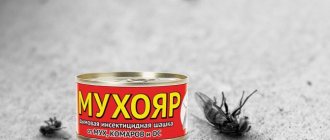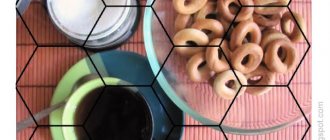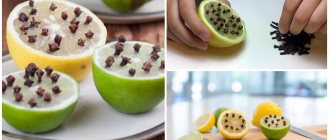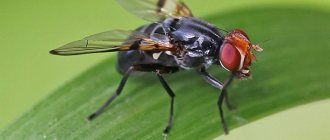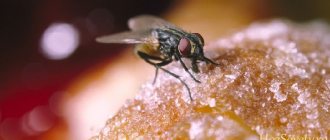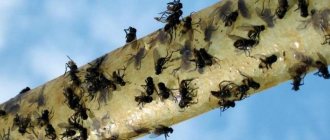If you thought that a fly was just one type of annoying insect, you should be disappointed. In Russia alone there are more than 400 species, and many of the synanthropic species (ecologically closely related to humans and their homes) pose a great danger to human health.
Today we are not talking about garden pests (onion, carrot, cabbage, iris and other flies), but rather about those dipterous insects that most often catch the eye of a person, and even actively attack him. So, who is here annoyingly curling and buzzing?
Housefly
The most common synanthropic species around the world is the housefly.
This yellow-gray insect is about 8 mm long with large faceted bright red eyes, a downward proboscis with “pads” at the end, large transparent wings and long black legs with suction cups.
How long do house flies live? A week or two or three - it all depends on the ambient temperature. The optimal temperature for insects is about 23°C. During her life, a female is capable of laying several clutches, up to 100 eggs in each, and she is capable of reproducing all year round - up to 20 generations of flies can change in a year in a warm apartment.
House flies do not bite humans; their mouthparts are not adapted for this. These are polyphags - they eat almost anything that their saliva can dissolve, or possibly scrape off with the help of the lobes of the oral apparatus. And a well-developed sense of smell helps the fly search for food.
Houseflies are harmful to humans, primarily by spoiling food, as well as by transmitting worm eggs and pathogens of many bacterial and viral infections (intestinal, eye, respiratory, etc.). Plus, insects in the apartment simply buzz annoyingly, and sit on a person’s skin and mucous membranes, trying to lick off sweat, blood from abrasions and other liquids.
How to get rid of flies in the house? They can develop in almost any decomposing substances of plant and animal origin, therefore, first of all, it is important to maintain cleanliness in the premises, timely removal of kitchen waste and garbage, and closed containers for its storage. To limit the entry of flies into the house, protective nets are used on windows and doors. Extermination measures consist of setting traps (sticky tapes, poisoned baits), mechanical extermination of insects, as well as the use of insecticides (especially in places where larvae develop), repellents and fumigators.
- House flies - why they are dangerous to humans and how to get rid of them
We offer proven means of controlling flies. We also tell you how to make a cool trap from an ordinary bottle!
House fly. Features of morphology. Life cycle and medical significance.
The housefly[1][2] (lat. Musca domestica) is a dipterous insect of the family of true flies.
The body length of an adult insect is 6-8 mm. The color is gray, on the upper side of the chest there are four black longitudinal stripes, the lower part of the abdomen is yellowish. The entire body is covered with sparse long hairs. The eyes are large, faceted, dark red in color. In females, the distance between the eyes is increased. So, in males the distance between the eyes is equal to 2/3 of the length of the eye, and in females it is equal to this length. Females are also larger in size than males.
Like all dipterans, only the front pair of wings is used for flight. The hind ones are reduced in size and are called halteres. They are necessary to maintain balance in the air.
The mouthparts are licking and sucking; house flies are not capable of biting through the skin and drinking blood, unlike similar autumn flies. Flies can only absorb liquid food; to consume solid food, they first dissolve it in saliva. The housefly is a polyphage. For the eggs to mature, the female needs protein food.
The female lays 70-120 white eggs at a time, about 1.2 mm in length. During her life, the female lays 6 or more ovipositions. Each clutch contains about 100 eggs. In total, during its life, a fly can lay from 600 to 2000 eggs, depending on climatic conditions. Under favorable conditions, M. domestica reproduces all year round
Egg development takes from 8 to 50 hours. Flies are insects with complete metamorphosis. The larvae of houseflies are up to 13 mm long, white, legless, pointed at the side of the mouth, and truncated at the back. They live in feces and other rotting semi-liquid media.
After 3-25 days and after three molts, the larva crawls into a cool, dry place and turns into a pupa, forming a puparium (a detached and hardened shell of the larva). The pupal phase lasts from 3 days. Adult insects usually live from two weeks to a month, but can live up to two months. 36 hours (that is, 1.5 days) after emerging from the pupa, they are already capable of reproduction.
Every year there are 9 to 20 generations of house flies. Both larvae and pupae, as well as adult fertilized females, overwinter. In cold rooms, flies survive the winter in an inactive state and awaken when the outside temperature is above 10 degrees.
Houseflies are a real nuisance to humans, especially on hot days. They are carriers of diseases, especially pathogens of intestinal infections, worm eggs, eye diseases and tuberculosis. The larvae can cause tissue and intestinal myiases[3].
To protect against flies, preventive measures are taken (storage of sewage, which serves as both food for flies and their larvae and a source of pathogenic microorganisms, out of the reach of flies) and various exterminatory measures (use of insecticides in places where larvae develop, poisoned baits, sticky tape traps and fly swatters in those places where adult insects are abundant). Using nets and other devices, flies are prevented from entering living spaces.
house fly
Although this fly is often confused with the one described above, they are different species, they even belong to different genera.
They are really similar in appearance, but unlike the housefly, the housefly is larger and darker, and its legs are dark yellow.
It causes as much harm as the indoor one, plus its larvae can parasitize warm-blooded animals, including humans, causing skin and abdominal inflammation-myiases.
Measures to combat house flies are similar to those used against house flies.
- Annoying and especially dangerous: 7 folk remedies for flies
Let's get acquainted with time-tested folk remedies for flies.
Nutrition
The house fly is diurnal and quiets down at dusk. During daylight hours, it searches for food and lays eggs. The house fly is a polyphage and feeds primarily on liquid food. Favorite dishes are fruit juices, jam, honey, syrup. In severe cases, when there is no other food, he eats sugar, cookies, bread crumbs, and candy.
On a note!
The mouthparts are piercing-sucking, but cannot bite through human skin. House flies do not feed on blood; autumn flies do this. They are very similar in appearance, so a person does not feel the substitution. Unlike its domestic relatives, the oral apparatus is equipped with sharp scales that act as teeth and gnaw through the skin of humans and animals. Minor differences in appearance - the wings are spread out to the sides.
There is no digestive system as such. Digestion of food occurs externally. The same feature is present in the larvae. Initially, the insect sprays a special secretion - saliva, which liquefies the food. After which the housefly calmly sucks up the liquid product. Digesting solid food requires more effort, so insects do not like this food very much.
Autumn fly
This synanthropic fly is very similar in appearance to the house fly, but unlike it, it is “shorter” and more compact, and most importantly, it does not have a licking-sucking mouthpart, but a piercing-sucking one (its proboscis is straight and sticks out forward, not down). This means that the zhigalka “bites” - sitting on the skin, it instantly drills through it, injecting saliva into the wound (it is because of this that the bite is so painful) and sucking out the blood. Both females and males bite.
Light flies attack quietly and unnoticed; unlike house flies, they will not fly around your apartment with a loud buzz or crawl along walls and tables. The number of these flies increases noticeably towards the end of summer - beginning of autumn, which is why “autumn” was added to the name.
Like the flies listed above, the zhigalka is a mechanical carrier of staphylococci, as well as the causative agents of anthrax, sepsis, tularemia and other diseases. If you have pets on your farm, there is a high probability that burner flies will “ruin their lives” with all their might.
The remedy for stinging flies is also similar - try to prevent them from entering apartments, and also deprive them of food sources and conditions for reproduction.
- Who bit me? Dangerous insects that are in your dacha
Bitten by an unknown insect - how to find out who it is and what to do to help the victim.
Features of life
Up to 20 generations of house flies change in a year. With the onset of cold weather, the insect climbs into the cracks and falls asleep. By the end of summer they become sleepy, inactive, and vulnerable. With the onset of the first frosts they disappear completely. The insect freezes, metabolic processes slow down, and the housefly falls asleep. With the onset of the first warm days, with an increase in air temperature to +10 degrees Celsius, it wakes up and continues its life activities.
Interesting!
In winter, in a warm room, when the bright sun is shining outside the window, the insect can wake up and get out of the cracks. But its activity does not last long - either the person kills or falls asleep again.
The homeland of the housefly is the steppes of Central Asia. This species is widespread everywhere. Does not live in the wild, lives in a house, apartment, or utility room.
Drosophila fly
Absolutely everyone knows these flies, although sometimes they don’t even suspect it. Remember the clouds of tiny (a couple of millimeters long) flies that appear in the room absolutely out of nowhere, as soon as you forget an apple core or a plum dripping with juice on the kitchen table for a few hours?
Meet the Drosophila fruit fly, also known in common parlance as a fruit fly. In fact, this insect is a most valuable object of genetic research, but for the average summer resident it is rather a terribly annoying creature, which is unclear as there are so many “invaders”; prepare traps for them from a glass with filler and a paper cone installed in it. Use apple cider vinegar or rotten pieces of fruit as this filler.
- How to get rid of fruit flies at home
A fruitful autumn is accompanied by an invasion of fruit flies, which somehow appear in the house. 10 reliable ways to get rid of them.
Blue, green and gray blow flies
Blue blowfly
You can easily recognize the first two of the listed dipterans by the bright “metallic” color of the body - it is really emerald green or deep blue.
Gray blowfly
The gray blowfly is not the same as the green and blue ones, it even belongs to a different family. These are large (up to 25 mm long) insects with bright red eyes and a gray body, most often painted with black stripes or spots.
They are all nicknamed “meat” because they rarely fly into human homes, but meat (as well as fish, dairy and fruit) markets, food warehouses, cowsheds, slaughterhouses, etc. - their favorite habitats. These insects can also be found in abundance near village toilets. These flies are especially active in the morning and evening hours.
The main danger of all blow flies for humans is the transfer of helminth eggs and intestinal infections, as well as food spoilage. The larvae of some species of gray flies (for example, Wohlfarth flies) can parasitize the tissues of mammals, feeding on living tissue and causing myiases.
In criminology and forensic entomology, blowfly larvae (maggots) developing in the tissues of corpses are widely used to determine the estimated time of death.
- Where do flies come from in the house in the fall and how to escape from them
Flies are a problem every autumn. Why are they attacking houses now and how to avoid it?
Gadfly
Yes, gadflies also belong to synanthropic flies, although many, due to their “fluffiness,” are more reminiscent of bees or bumblebees.
These are large (up to 3 cm in length) insects with a gray or yellowish, sometimes striped body, abundantly covered with hairs.
Gadflies in our latitudes do not attack or bite humans. They are dangerous parasites of large animals - a person can suffer from these insects only if the eggs of the gadfly somehow get on his mucous membrane or under the skin. But if a female gadfly decides to pierce your skin to lay larvae, you will notice this by large swelling and redness, as well as severe itching. Botfly larvae can also cause myiasis.
- 7 dangerous insects that lie in wait for us in the country and beyond
Rating of insects, after bites of which you need to urgently take safety measures.
Development
The adult develops throughout the warm season; year-round development of the insect can be observed indoors.[7]
The flies emerge from the puparia and, using the frontal bladder, climb to the soil surface. They sit motionless for some time, then begin to move quickly and freeze again. Only after two hours do they begin an active lifestyle. Under normal conditions, insects live 18-20 days.[6]
Mating period. 5-7 days after emerging from the pupae, flies become capable of laying eggs. At one time they lay 100-150 eggs. There can be several clutches, usually 6-8.[1] In this case, a substrate is used that feeds the larvae; Often the masonry is carried out not directly on it, but nearby.[7]
Egg. The development period depends on temperature and ranges from 8 to 25 hours.[6]
The larva goes through three instars in its development and develops in human and animal feces, food waste and rotting plant debris. The depth of placement depends on the temperature and aeration of the substrate. Third instar larvae eat the larvae of other flies.[3] Development at a temperature of +38-45°C takes 3-4 days. A temperature of +52 °C is fatal for house fly larvae.[6]
Upon completion of growth, the insect stops feeding and enters the prepupal stage. Under favorable conditions, this stage takes no more than a day, but development is often delayed. Prepupae are capable of vertical and horizontal migration.[6]
Horsefly
But blood-sucking horse flies attack humans and livestock very actively, often in large numbers. Their bites are very painful, and the bite site swells greatly due to saliva and anticoagulants injected under the skin (and the latter also contribute to prolonged bleeding from the wound).
And this is not just an unpleasant process - horsefly bites transmit many dangerous diseases to humans and livestock, from anthrax and tick-borne encephalitis to tularemia, listeriosis, dermatitis and allergies.
Externally, the horsefly is not difficult to identify - it is a large (up to 3 cm long) two-winged insect with a dark, sometimes striped, flattened body and huge eyes. They fly very quickly and can actively attack people, especially in the hottest part of the day and when the skin is moistened with water or sweat - during swimming, physical work in the air, or simply when being near bodies of water.
Features of the structure of the house fly
The main difference between the housefly and other relatives is the presence of only one pair of wings.
During the evolution of the insect, the second posterior pair turned into haltere appendages used to maintain balance.
In addition, the insect, despite the complex structure of the eye, is blind. The visibility limit is limited to a distance of 40 - 70 cm.
External structure
The skeletal structure of the housefly is no different from other classes of insects.
Represented by the head, chest and abdomen. The head is equipped with mouthparts, eyes and antennae.
Appearance of a housefly
The chest has a segmental structure - there are three of them. There are two wings, they are completely transparent. Legs - three pairs.
Well-developed muscles are located in the chest cavity. Inside the abdomen are located the main part of the digestive organs and the entire reproductive system.
Breast
The chest is represented by three interconnected segments. The prothorax, midthorax and metathorax are distinguished.
The insect gains the ability to fly due to its powerful muscles, so the middle segment is the most developed.
The body is equipped with three pairs of legs, each of which is divided into five interconnected particles. The paws have well-developed muscles.
At the tips of the paws there are miniature claws and suction cups, with the help of which the insect is able to attach and hold on to any surface.
Housefly foot under a microscope
Thanks to this, houseflies have the ability to move upward with their abdomen. During movement, a sticky secretion is released from the pads as a result of compression.
This feature helps the fly to hold firmly on the glass and absolutely smooth surface.
The housefly's legs serve as olfactory organs. Thanks to the villi receptors located on them, the insect will determine whether food is edible or inedible.
Head
The structure of a fly's head is simple. On its surface are the organs of vision, hearing and nutrition.
The mouthparts of a fly - the structure depends on the type of food the insect eats - is represented by a proboscis of a licking or sucking format.
The lips, represented by the lower and upper blades, come into direct contact with the food mass.
Housefly mouthparts
A large number of channels through which food enters the digestive system converge in the food proboscis of the fly.
The fly has a powerful jaw apparatus. The mouthparts of the fly, whose diet is based on blood, have sharp and hard scales.
This is a kind of imitation of teeth that help the fly damage the surface of human skin. The pump located in the pharynx is responsible for drawing in liquid and liquefied food.
You can also read our article: What do flies eat at home?
Most of the surface of the head is occupied by the eyes, which have a very complex structure. They are composed of a large number of simple eyes.
Visually – when zoomed in significantly – it looks like a faceted mesh.
Eyes of a fly
This structure provides the housefly with a comprehensive image of objects, but the overall picture is perceived as a mosaic.
The total number of simple eyes of a housefly reaches 4 thousand. The insect is able to instantly react to any movement, but it does not receive a full-fledged three-dimensional image.
The antennae are used by insects as landmarks. They help in perceiving different smells and determining the direction of flight and movement. They have characteristic differences in females and males.
Wings
The structure of a fly's wing is simple. The insect has one pair of wings. They are well developed, completely transparent, and have membranes.
The strength of the wing is ensured by the cylindrical veins running through it. The posterior pair was transformed into haltere appendages during evolution. Wings help the fly maintain balance during flight.
Housefly wings
In addition, they allow you to hover in the air if necessary. During the flight they emit a characteristic buzzing sound.
In flight, a housefly can turn off one of its wings, which helps it sharply change its flight path, perform complex maneuvers, and take off from a standstill without a preliminary run-up.
Belly
The abdomen of a housefly has the shape of an elongated cylinder.
Segmental, represented by ten interconnected segment particles.
Fly body
Inside the abdominal cavity there are organs of the reproductive, respiratory, digestive and other vital systems.
The surface of the abdomen is covered with a chitinous layer with good elasticity. If necessary - after eating and during the period of bearing offspring - the cover can expand.
Internal structure
The internal structure of the fly is represented by the digestive system, reproductive system and other organs important for the life of the insect.
Digestive system
The abdominal cavity of the insect contains the main part of the organs responsible for and ensuring the absorption of food.
This:
- goiter;
- intestines;
- Malpighian vessels;
- excretory tubules.
The housefly does not have a digestive system in its direct sense. Food is digested before it enters the insect’s gastrointestinal tract, i.e. food enters the cavity of the goiter in a form completely ready for absorption. Before the fly begins to absorb food, it treats it with a special secretion, which ensures its digestion.
Sexual and reproductive system
The abdominal cavity also contains the internal genital organs. In males these are testes, in females these are eggs, accessory glands and ducts.
The external genitalia of housefly subspecies have their own characteristic features.
Males are distinguished by the special structure of their grips, with the help of which they hold the female during the mating process.
Fly egg laying
The number of eggs in a housefly clutch varies and can reach 70 – 150 pieces. The number depends on the subspecies of the insect.
Other insect body systems
The brain consists of numerous nerve nodes that are located in different parts of the insect’s body. The complex brain system inherent in humans is absent in insects.
The main task of the brain is to help coordinate movements. Another organ is responsible for reflexes - the reflex arc.
The brain is tiny in size but made up of several hundred thousand neurons. This helps the insect perform incredibly complex maneuvers during flight.
The circulatory system is represented by the following organs:
- aorta;
- pterygoid muscle;
- dorsal vessel;
- heart.
The heart has a simple structure. The organ does not perform functions familiar to humans.
The circulatory system is filled with blood - a completely colorless or slightly yellowish liquid.
Diagram of the circulatory system of a fly
The main function of this biological fluid is to transport the nutrients necessary for the insect. It does not take part in the transfer of oxygen and does not contain red blood cells.
The respiratory system is represented by a large number of tracheas, which are located throughout the body. The flow of oxygen into the respiratory canals is ensured by the opening of the spiracles.
The trachea, in turn, are highly branched, representing a rather complex capillary system. Thanks to this, oxygen is supplied directly to vital organs.
In total, the insect has 10 pairs of spiracles: two are on the surface of the chest, the remaining eight pairs are on the lower surface of the abdomen.
Conclusion
The housefly, despite its outward primitiveness, is a flying two-winged insect with a rather complex internal and external structure.
Ktyr
These flies, strictly speaking, have little interest in humans. Ktyri are active and aggressive hunters of insects. But, if touched or caught, they will definitely bite a person. The saliva of moths contains a strong poison, from which the insects caught by it die instantly, and a person develops painful swelling.
Eggs are laid on wood or grass, and the larvae feed on decaying organic debris.
How to identify a bird? They have large eyes and a slender, often elongated and usually short, densely pubescent, orange-yellow body. The sizes of the ktyres are very different, from 3 to 50 mm.
Bloodsuckers
These flies bear little resemblance to the flies we are used to; when you first meet them, you may even confuse them with ticks. And the whole point is that when they get on the body of the host animal, most of them shed their wings. They have a flattened body several mm long and strong, widely spaced legs with tenacious claws.
Bloodsuckers, as the name implies, feed exclusively on the blood of warm-blooded animals and are specialized parasites. Preferring livestock, dogs, wild ungulates and sometimes even birds as hosts, bloodsuckers, when in high numbers, can attack humans and feed on their blood. Having sat on the body, they will try to quickly get into the hair or under clothing. At the site of their bites, an itchy papule develops, which lasts up to three weeks.
Other popular names for the bloodsucker are moose fly, moose tick, sheep tick, runets, moose louse, etc.
Of course, we have not listed all the flies that a person may encounter and be bitten in our latitudes. On occasion, these can be toothpods, market flies, etc. But usually their numbers are not so large, and the bites are not so painful and dangerous.
There are other beneficial flies that you may encounter on your property - for example, tachinids (hedgeflies) parasitize insect pests, and hoverflies help pollinate plants or destroy harmful insects.



